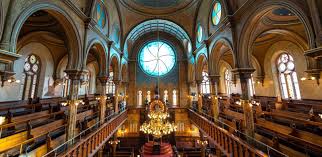NEW HAVEN — Rabbi Lauren Holtzblatt, new assistant rabbi at Yale Universitys Slifka Center, has quickly fallen in love with her job and the Yale community.
One of the great things about Jewish life at Yale is that you dont have to define yourself here, she notes. There are people who are comfortable not committing themselves to one movement.
Holtzblatt explains that some students comfortably attend both the Conservative minyan and either Minyan Urim (separate seating minyan with women permitted to read Torah and lead parts of the prayer service) or the Orthodox minyan. While Holtzblatt, recently ordained at the Jewish Theological Seminary of America, will be working with the Conservative minyan, she will also be involved with many Slifka Center-wide programs including teaching classes and reaching out to unaffiliated students.
Holtzblatt praises the already strong Carlebach-style Friday night minyan and the Downtown (Conservative) (Shabbat morning) Minyan, which tends to mainly attract somewhat older community members. Holtzblatt will be working with Conservative students on campus by listening to what they need and helping them figure out who they are. Holtzblatt has thus far organized a meeting of 12 students who are committed to setting up a once a month Shabbat morning Conservative minyan, scheduled to start Oct. 20, which may evolve into a service which meets more often.
While Holtzblatt only joined the Slifka team at the end of the summer, she has already implemented and been actively involved with some out of the box programs, including a Rosh Hashanah Block Party on Wall Street-complete with apple tasting and honey bobbing–and a post Kol Nidrei Bang Out Your Sins drumming circle-a combination of drumming and learning about the meaning of teshuva (repentance).
Holtzblatt is a keen observer of the Slifka scene. She has noticed that 100-150 students walk through the doors at Slifka on a given Friday night and are finished Shabbat dinner by 8pm. She notes, We need to ask, What can we do to enhance their Shabbat?
Holtzblatt will undoubtedly draw from the training she received at Manhattans famed Bnai Jeshurun (BJ) Synagogue, known for its commitment to social justice and its innovative use of music in prayer services. At Bnai Jeshurun, she was actively involved in running programs for 20 and 30 somethings, which included Friday night dinners and a post-dinner tisch.
According to BJ Rabbi Roly Matalon, Lauren has made a tremendous impact here at BJ during her two-year Marshall Meyer fellowship. She has a strong commitment to building community through serious learning, prayer, and gemilut hasadim. She is passionate about social justice and has a clear understanding of how Judaism mandates our concern and involvement.



